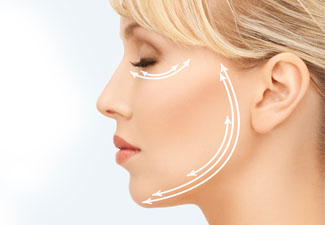Facial Plastic Surgery

Rhinoplasty
A rhinoplasty is a surgical procedure that changes the appearance and shape of your nose. It can also improve structural defects like a deviated septum, which can make it difficult to breathe. Dr. Rubinstein uses rhinoplasty to change the size or width of your nose, remove bumps on the bridge, reshape the nasal tip, resize the nostrils and correct nasal asymmetry. During the procedure, patients are under general anesthesia and return home to recover. During the initial healing process, a splint or bandages will be used to support the new nasal structures. Results will begin to appear within a few weeks after the swelling goes down. It can take up to a year to see the full results of the facial plastic surgery as the new structures set.
Facelift | Brow Lift | Eyelid Lift
Facelift, Brow Lift and Eyelid Lift procedures are often used in combination to help patients look younger. Facelifts primarily tighten skin on the face and neck. Dr. Rubinstein makes a small incision along the hairline and repositions the tissues to reduce the appearance of wrinkles and fine lines. Sometimes excess fat from the neck and jowls may be relocated to give the face more volume. The incisions from a facelift are normally concealed within the hairline, therefore, scars will not be visible. Brow lifts are similar to facelifts, but focus on the forehead area. Lifting the forehead can reduce wrinkles and frown lines to help you look younger and more alert. Eyelid surgery can be performed on both the upper and lower lids. It is an effective treatment for bags under the eyes, wrinkles, loose skin, and drooping eyelids. Results will appear gradually as the swelling decreases.


Otoplasty (Ear Repair)
An otoplasty surgically alters the size, shape or position of the ear. Dr. Rubinstein performs otoplasty procedures to correct protruding or oversized ears to provide a better cosmetic result. Because the surgical incisions are often made on the back of the ear, any scars will be well-hidden.. After treatment, pain medication will help alleviate discomfort. Patients may experience some itching in the area below the bandages, but should avoid scratching or removing their bandages. Depending on your aesthetic goals, more than one surgery may be needed to achieve the best results.
